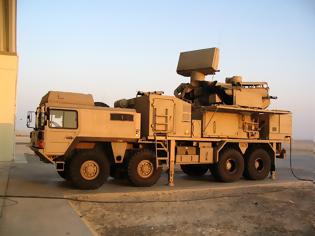2012-06-25 07:40:35

Pantsyr-1
Turkish Air Force F-4 Super Phantom Friday, June 22, over Latakia Syria used Russian-made self-propelled medium range anti-air Pantsyr-1 missiles recently supplied by Moscow (not as first reported anti-air Buk-M2 missiles). This weapon can down aircraft flying at altitudes up to 12 kilometers and cruise missiles. The unit responsible for the ambush was the 73rd brigade of the Syrian army’s 26th Air Defense Division.
Since the sophisticated weapons were delivered to the Assad regime in recent weeks, it must be assumed that local missile crews had not finished training in their use and would have had to rely on help from their Russian instructors to fire one.
This would be the first instance in the 15-month Syrian uprising of an advanced Russian-supplied weapon hitting the military target of a NATO member. Hence the comment from Washington by US State Department spokesperson Victoria Nuland who said: “We’ve seen the reports… We have obviously been in contact with our Turkish ally…. To my knowledge, they haven’t raised this at NATO at this point.”
Ankara has repeatedly threatened to ask NATO to invoke the pact’s article 5 obligating members to come to the aid of a fellow member coming under attack. In this case, however, the Turkish Prime Minister Tayyip Erdogan’s rhetoric was relatively restrained. He vowed to “determinedly take necessary steps” in response “once the incident is fully clarified,” leaving Ankara’s response deliberately vague.
President Abdullah Gul spoke out more strongly: “It is impossible to ignore our fighter jet being shot down by Syria,” he said after Damascus admitted to shooting down the plane, claiming its air defenses acted according to standard procedure before realizing it was a Turkish air force jet. Both are searching for the two missing pilots.
This was also the first time in five years any weapons system with Israeli manufacturing input had faced a Russian weapon acquired by Syria. The first time was September 6, 2007, when Israeli fighter-bombers demolished the Iranian-North Korean-built nuclear reactor in the northern Syrian town of Al-Kibar. Airspace over the reactor was guarded by Russian Pantsyr-S1 anti-air missiles. Israeli bombers got through by disabling the Russian missiles’ radar so that Damascus never realized its reactor was being bombed until it had been smashed and Israeli bombers were home.
Five years later, Turkey has lost a Super Phantom which had undergone partial upgrading by the Israeli Aerospace Industry. However, two years ago, Ankara broke off its security and military ties with Jerusalem after a clash at sea between Turkish Mavi Marmara and Israel troops wich intercepted the vessel on its way to break Israel’s Gaza blockade, leaving nine Turkish pro-Palestinian activists dead.
By severing those ties, the Erdogan government left Israel’s improvements unfinished and the Turkish air force’s F-4 short of counter-measures for evading or attacking the latest Russian-made air defense weapons fired by Syria.
Πηγή
InfoGnomon
Turkish Air Force F-4 Super Phantom Friday, June 22, over Latakia Syria used Russian-made self-propelled medium range anti-air Pantsyr-1 missiles recently supplied by Moscow (not as first reported anti-air Buk-M2 missiles). This weapon can down aircraft flying at altitudes up to 12 kilometers and cruise missiles. The unit responsible for the ambush was the 73rd brigade of the Syrian army’s 26th Air Defense Division.
Since the sophisticated weapons were delivered to the Assad regime in recent weeks, it must be assumed that local missile crews had not finished training in their use and would have had to rely on help from their Russian instructors to fire one.
This would be the first instance in the 15-month Syrian uprising of an advanced Russian-supplied weapon hitting the military target of a NATO member. Hence the comment from Washington by US State Department spokesperson Victoria Nuland who said: “We’ve seen the reports… We have obviously been in contact with our Turkish ally…. To my knowledge, they haven’t raised this at NATO at this point.”
Ankara has repeatedly threatened to ask NATO to invoke the pact’s article 5 obligating members to come to the aid of a fellow member coming under attack. In this case, however, the Turkish Prime Minister Tayyip Erdogan’s rhetoric was relatively restrained. He vowed to “determinedly take necessary steps” in response “once the incident is fully clarified,” leaving Ankara’s response deliberately vague.
President Abdullah Gul spoke out more strongly: “It is impossible to ignore our fighter jet being shot down by Syria,” he said after Damascus admitted to shooting down the plane, claiming its air defenses acted according to standard procedure before realizing it was a Turkish air force jet. Both are searching for the two missing pilots.
This was also the first time in five years any weapons system with Israeli manufacturing input had faced a Russian weapon acquired by Syria. The first time was September 6, 2007, when Israeli fighter-bombers demolished the Iranian-North Korean-built nuclear reactor in the northern Syrian town of Al-Kibar. Airspace over the reactor was guarded by Russian Pantsyr-S1 anti-air missiles. Israeli bombers got through by disabling the Russian missiles’ radar so that Damascus never realized its reactor was being bombed until it had been smashed and Israeli bombers were home.
Five years later, Turkey has lost a Super Phantom which had undergone partial upgrading by the Israeli Aerospace Industry. However, two years ago, Ankara broke off its security and military ties with Jerusalem after a clash at sea between Turkish Mavi Marmara and Israel troops wich intercepted the vessel on its way to break Israel’s Gaza blockade, leaving nine Turkish pro-Palestinian activists dead.
By severing those ties, the Erdogan government left Israel’s improvements unfinished and the Turkish air force’s F-4 short of counter-measures for evading or attacking the latest Russian-made air defense weapons fired by Syria.
Πηγή
InfoGnomon
ΜΟΙΡΑΣΤΕΙΤΕ
ΔΕΙΤΕ ΑΚΟΜΑ
ΠΡΟΗΓΟΥΜΕΝΟ ΑΡΘΡΟ
Ερώτηση αναγνώστη για τη συμπλήρωση μηχανογραφικού πανελληνίων 2012
ΣΧΟΛΙΑΣΤΕ














